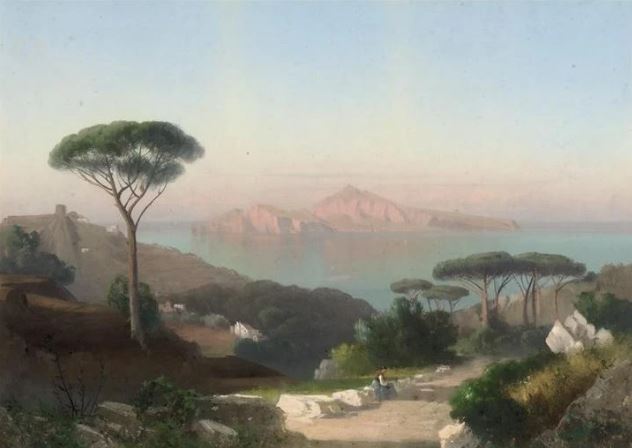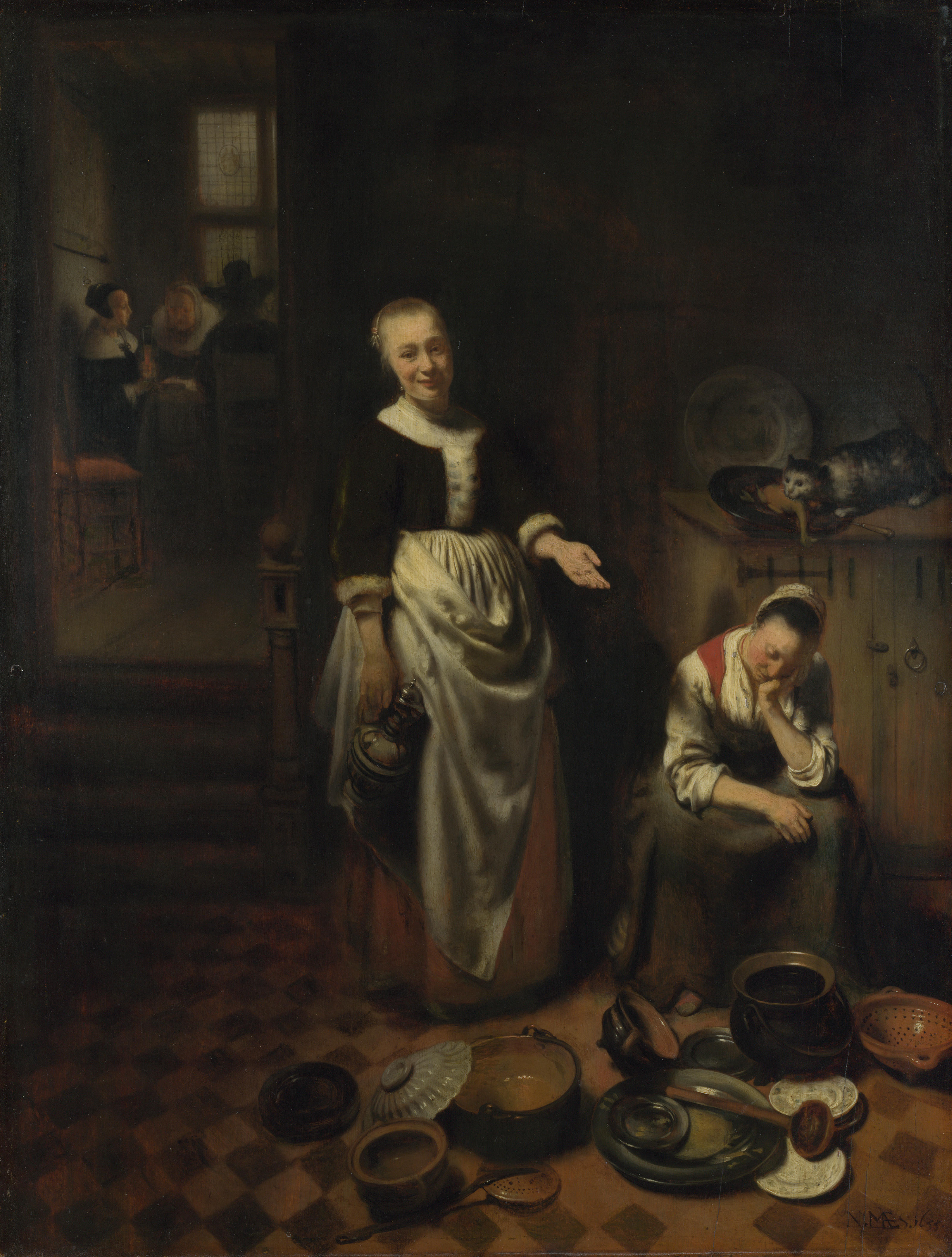|
Cesare Uva
Cesare Uva (11 November 1824, Avellino – 16 February 1886, Naples) was an Italian landscape painter. Life and work He was born to Mariano Uva, an interior decorator, and his wife Lucia, née D'Argenio.Stefano Orga, ''L'Ottocento di Cesare Uva'', exhibition catalog, Palazzo Vescovile, 2016News of the exhibition @ Arte.it His early display of artistic talent was strongly encouraged by his father. At the age of twenty-six, he moved to Naples, where he attended the Royal Academy of Fine Arts. His primary instructor there was Gabriele Smargiassi. ''Dizionario degli Artisti Italiani Viventi: pittori, scultori, e Architetti.'' by |
Genre Art
Genre art is the pictorial representation in any of various media of scenes or events from everyday life, such as markets, domestic settings, interiors, parties, inn scenes, work, and street scenes. Such representations (also called genre works, genre scenes, or genre views) may be realistic, imagined, or romanticized by the artist. Some variations of the term ''genre art'' specify the medium or type of visual work, as in ''genre painting'', ''genre prints'', ''genre photographs'', and so on. The following concentrates on painting, but genre motifs were also extremely popular in many forms of the decorative arts, especially from the Rococo of the early 18th century onwards. Single figures or small groups decorated a huge variety of objects such as porcelain, furniture, wallpaper, and textiles. Genre painting ''Genre painting'', also called ''genre scene'' or ''petit genre'', depicts aspects of everyday life by portraying ordinary people engaged in common activities. One commo ... [...More Info...] [...Related Items...] OR: [Wikipedia] [Google] [Baidu] |
Painters From Naples
Painting is the practice of applying paint, pigment, color or other medium to a solid surface (called the "matrix" or "support"). The medium is commonly applied to the base with a brush, but other implements, such as knives, sponges, and airbrushes, can be used. In art, the term ''painting ''describes both the act and the result of the action (the final work is called "a painting"). The support for paintings includes such surfaces as walls, paper, canvas, wood, glass, lacquer, pottery, leaf, copper and concrete, and the painting may incorporate multiple other materials, including sand, clay, paper, plaster, gold leaf, and even whole objects. Painting is an important form in the visual arts, bringing in elements such as drawing, composition, gesture (as in gestural painting), narration (as in narrative art), and abstraction (as in abstract art). Paintings can be naturalistic and representational (as in still life and landscape painting), photographic, abstract, narrat ... [...More Info...] [...Related Items...] OR: [Wikipedia] [Google] [Baidu] |
Italian Male Painters
Italian(s) may refer to: * Anything of, from, or related to the people of Italy over the centuries ** Italians, an ethnic group or simply a citizen of the Italian Republic or Italian Kingdom ** Italian language, a Romance language *** Regional Italian, regional variants of the Italian language ** Languages of Italy, languages and dialects spoken in Italy ** Italian culture, cultural features of Italy ** Italian cuisine, traditional foods ** Folklore of Italy, the folklore and urban legends of Italy ** Mythology of Italy, traditional religion and beliefs Other uses * Italian dressing, a vinaigrette-type salad dressing or marinade * Italian or Italian-A, alternative names for the Ping-Pong virus, an extinct computer virus See also * * * Italia (other) * Italic (other) * Italo (other) * The Italian (other) The Italian may refer to: * ''The Italian'' (1915 film), a silent film by Reginald Barker * ''The Italian'' (2005 film), a Russian film by A ... [...More Info...] [...Related Items...] OR: [Wikipedia] [Google] [Baidu] |
Artists From The Kingdom Of The Two Sicilies
An artist is a person engaged in an activity related to creating art, practicing the arts, or demonstrating an art. The common usage in both everyday speech and academic discourse refers to a practitioner in the visual arts only. However, the term is also often used in the entertainment business, especially in a business context, for musicians and other performers (although less often for actors). "Artiste" (French for artist) is a variant used in English in this context, but this use has become rare. Use of the term "artist" to describe writers is valid, but less common, and mostly restricted to contexts like used in criticism. Dictionary definitions The '' Oxford English Dictionary'' defines the older broad meanings of the term "artist": * A learned person or Master of Arts. * One who pursues a practical science, traditionally medicine, astrology, alchemy, chemistry. * A follower of a pursuit in which skill comes by study or practice. * A follower of a manual art, such ... [...More Info...] [...Related Items...] OR: [Wikipedia] [Google] [Baidu] |
19th-century Italian Painters
The 19th (nineteenth) century began on 1 January 1801 ( MDCCCI), and ended on 31 December 1900 ( MCM). The 19th century was the ninth century of the 2nd millennium. The 19th century was characterized by vast social upheaval. Slavery was abolished in much of Europe and the Americas. The First Industrial Revolution, though it began in the late 18th century, expanding beyond its British homeland for the first time during this century, particularly remaking the economies and societies of the Low Countries, the Rhineland, Northern Italy, and the Northeastern United States. A few decades later, the Second Industrial Revolution led to ever more massive urbanization and much higher levels of productivity, profit, and prosperity, a pattern that continued into the 20th century. The Islamic gunpowder empires fell into decline and European imperialism brought much of South Asia, Southeast Asia, and almost all of Africa under colonial rule. It was also marked by the collapse of the large ... [...More Info...] [...Related Items...] OR: [Wikipedia] [Google] [Baidu] |
People From Avellino
A person ( : people) is a being that has certain capacities or attributes such as reason, morality, consciousness or self-consciousness, and being a part of a culturally established form of social relations such as kinship, ownership of property, or legal responsibility. The defining features of personhood and, consequently, what makes a person count as a person, differ widely among cultures and contexts. In addition to the question of personhood, of what makes a being count as a person to begin with, there are further questions about personal identity and self: both about what makes any particular person that particular person instead of another, and about what makes a person at one time the same person as they were or will be at another time despite any intervening changes. The plural form "people" is often used to refer to an entire nation or ethnic group (as in "a people"), and this was the original meaning of the word; it subsequently acquired its use as a plural form of p ... [...More Info...] [...Related Items...] OR: [Wikipedia] [Google] [Baidu] |
1886 Deaths
Events January–March * January 1 – Upper Burma is formally annexed to British Burma, following its conquest in the Third Anglo-Burmese War of November 1885. * January 5– 9 – Robert Louis Stevenson's novella '' Strange Case of Dr Jekyll and Mr Hyde'' is published in New York and London. * January 16 – A resolution is passed in the German Parliament to condemn the Prussian deportations, the politically motivated mass expulsion of ethnic Poles and Jews from Prussia, initiated by Otto von Bismarck. * January 18 – Modern field hockey is born with the formation of The Hockey Association in England. * January 29 – Karl Benz patents the first successful gasoline-driven automobile, the Benz Patent-Motorwagen (built in 1885). * February 6– 9 – Seattle riot of 1886: Anti-Chinese sentiments result in riots in Seattle, Washington. * February 8 – The West End Riots following a popular meeting in Trafalgar Square, Lo ... [...More Info...] [...Related Items...] OR: [Wikipedia] [Google] [Baidu] |
1824 Births
Eighteen or 18 may refer to: * 18 (number), the natural number following 17 and preceding 19 * one of the years 18 BC, AD 18, 1918, 2018 Film, television and entertainment * ''18'' (film), a 1993 Taiwanese experimental film based on the short story ''God's Dice'' * ''Eighteen'' (film), a 2005 Canadian dramatic feature film * 18 (British Board of Film Classification), a film rating in the United Kingdom, also used in Ireland by the Irish Film Classification Office * 18 (''Dragon Ball''), a character in the ''Dragon Ball'' franchise * "Eighteen", a 2006 episode of the animated television series '' 12 oz. Mouse'' Music Albums * ''18'' (Moby album), 2002 * ''18'' (Nana Kitade album), 2005 * '' 18...'', 2009 debut album by G.E.M. Songs * "18" (5 Seconds of Summer song), from their 2014 eponymous debut album * "18" (One Direction song), from their 2014 studio album ''Four'' * "18", by Anarbor from their 2013 studio album ''Burnout'' * "I'm Eighteen", by Alice Cooper comm ... [...More Info...] [...Related Items...] OR: [Wikipedia] [Google] [Baidu] |
Vedute
A ''veduta'' ( Italian for "view"; plural ''vedute'') is a highly detailed, usually large-scale painting or, more often, print of a cityscape or some other vista. The painters of ''vedute'' are referred to as ''vedutisti''. Origins This genre of landscape originated in Flanders, where artists such as Paul Bril painted ''vedute'' as early as the 16th century. In the 17th century, Dutch painters made a specialty of detailed and accurate recognizable city and landscapes that appealed to the sense of local pride of the wealthy Dutch middle class. An archetypal example is Johannes Vermeer's '' View of Delft''. The Ghent architect, draughtsman and engraver Lieven Cruyl (1640–1720) contributed to the development of the ''vedute'' during his residence in Rome in the late 17th century. Cruyl’s drawings reproduce the topographical aspects of the urban landscape. 18th century As the itinerary of the Grand Tour became somewhat standardized, ''vedute'' of familiar scenes like the Ro ... [...More Info...] [...Related Items...] OR: [Wikipedia] [Google] [Baidu] |
Cesare Uva Veduta Del Vesuvio
Cesare, the Italian version of the given name Caesar, may refer to: Given name * Cesare, Marquis of Beccaria (1738–1794), an Italian philosopher and politician * Cesare Airaghi (1840–1896), Italian colonel * Cesare Arzelà (1847–1912), Italian mathematician * Cesare Battisti (other) * Cesare Bocci (born 1957), Italian actor known for the ''Inspector Montalbano'' TV series * Cesare Bonizzi, Franciscan friar and heavy metal singer * Cesare Borgia (1475–1507), Italian general and statesman * Cesare "Cece" Carlucci (1917–2008), American baseball umpire * Cesare Emiliani (1922–1995), Italian-American scientist * Cesare Fiorio (born 1939), Italian sportsperson * Cesare Gianturco (1905–1995), Italian-American physician * Cesare Nava (1861–1933), Italian engineer and politician * Cesare Negri, the late Renaissance dancing-master * Cesare Pavese (1908–1950), Italian poet and novelist * Cesare Romiti (1923–2020), Italian economist and business ... [...More Info...] [...Related Items...] OR: [Wikipedia] [Google] [Baidu] |
Staffage
In painting, staffage () are the human and animal figures depicted in a scene, especially a landscape, that are not the primary subject matter of the work. Typically they are small, and there to add an indication of scale and add interest. Before the adoption of the word into the visual arts in the late eighteenth and early nineteenth centuries, ''Staffage'' in German could mean "accessories" or "decoration". The word can be used in two senses: as a general term for any figures in a work, even when they are, at least ostensibly, the main subject, and as a descriptive term for figures to whom no specific identity or story is attached, included merely for compositional or decorative reasons. In the latter sense, staffage are accessories to the scene, yet add life to the work; they provide depth to the painting and reinforce the main subject, as well as giving a clear scale to the rest of the composition. During the Baroque, painters such as Nicolas Poussin and Claude Lorrain comm ... [...More Info...] [...Related Items...] OR: [Wikipedia] [Google] [Baidu] |




_1938.jpg)


